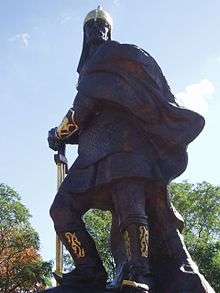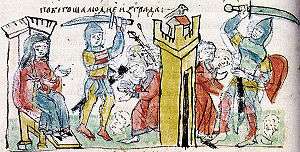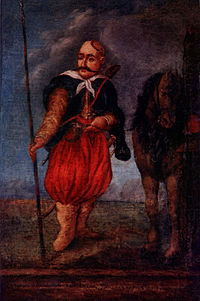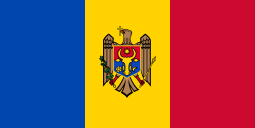Korosten
Korosten (Ukrainian: Ко́ростень, historically also Iskorosten Іскоростень) is a historic city and a large transport hub in the Zhytomyr Oblast (province) of northern Ukraine. It is located on the Uzh River. Korosten serves as the administrative center of the Korosten Raion (district), though administratively it is not part of the raion and is incorporated as a city of regional significance. Its population is approximately 64,256 (2017 est.)[4], 63525 (January 1, 2018 est.).[5]

Korosten Коростень | |
|---|---|
| Korosten | |
Main street of Korosten | |
 Coat of arms | |
 Korosten Location of Korosten  Korosten Korosten (Ukraine) | |
| Coordinates: 50°57′N 28°38′E | |
| Country | |
| Oblast | |
| Raion | Korosten Raion |
| First mentioned | AD 705 |
| Charter granted | 1589 |
| City Status | 1 January 1926[1][2] |
| City council | Korosten City Council |
| Government | |
| • Mayor | Wolodymyr Moskalenko |
| Area | |
| • Total | 42.31 km2 (16.34 sq mi) |
| Elevation | 171 m (561 ft) |
| Population (1 January 2018) | |
| • Total | 63,525[3] |
| GDP (2020) | |
| Time zone | UTC+2 (EET) |
| • Summer (DST) | UTC+3 (EEST) |
| Postal code | 01xxx–04xxx |
| Area code(s) | +380 44 |
| FIPS code | UP27 |
| Vehicle registration plate | AA |
| Website | Official website |
Name
There are different theories about the origin of the name of the city.
The name may be derived from the word korost, 'brushwood, bushes, shrubbery'; the form Iskorosten sometimes found in early sources is probably based on the common repetition of prepositions in Old East Slavic: iz grada iz... 'from the city from...'.[6]
Another theory holds that the city was built entirely of wood, and its walls were surrounded by an oak fence, unhewn, with bark, leading to the name Is-koro-sten, i.e. the city "from bark on the wall" in Ukrainian.
Alternatively, the city might have been named after the sun god Kors (Horus) - the main god of many tribes that inhabited the area, including the Drevlians. According to this theory, the names of the settlements of Korsun and Korostyshiv also come from Hors / Kors.
History
Early History
![]()
![]()
![]()
![]()
![]()
![]()
![]()
![]()
![]()
The city was founded over a millennium ago and was the capital of the Drevlyans, an ancient Slavic tribe (later incorporated into Kievan Rus′).[6]
The Rus

In 945, Prince Igor of Kiev ruler of the Kievan Rus was killed in while collecting tribute from the Drevlians in Iskorosten. According to 10th century Byzantine historian and chronicler, Leo the Deacon: "They [Drevlians] had bent down two birch trees to the prince's feet and tied them to his legs; then they let the trees straighten again, thus tearing the prince's body apart."[7] The Primary Chronicle blames Igor’s death on his own excessive greed, indicating that he tried to collect tribute for a second time in a month.
Igor's widow, Olga of Kiev, as regent on behalf of their son Svyatoslav.[8] avenged his death by punishing the Drevlians. Olga then led her army to Iskorosten. The siege lasted for a year without success, when Olga thought of a plan to trick the Drevlians. She sent them a message: “Why do you persist in holding out? All your cities have surrendered to me and submitted to tribute, so that the inhabitants now cultivate their fields and their lands in peace. But you had rather tide of hunger, without submitting to tribute.”[9] The Drevlians responded that they would submit to tribute, but that they were afraid she was still intent on avenging her husband. Olga answered that the murder of the messengers sent to Kiev, as well as the events of the feast night, had been enough for her. She then asked them for a small request: “Give me three pigeons...and three sparrows from each house.”[9] The Drevlians rejoiced at the prospect of the siege ending for so small a price, and did as she asked.
Olga then instructed her army to attach a piece of sulphur bound with small pieces of cloth to each bird. At nightfall, Olga told her soldiers to set the pieces aflame and release the birds. They returned to their nests within the city, which subsequently set the city ablaze. As the Primary Chronicle tells it: “There was not a house that was not consumed, and it was impossible to extinguish the flames, because all the houses caught fire at once.”[9] As the people fled the burning city, Olga ordered her soldiers to catch them, killing some of them and giving the others as slaves to her followers. She left the remnant to pay tribute. As a result of this Olga changed the system of tribute gathering (poliudie) in what may be regarded as the first legal reform recorded in Eastern Europe.
In 968 the nomadic Pechenegs attacked outlying regions of the Rus and then besieged the city.[10]
The Middle Ages
After the partition of Rus in 1097, Iskorosten remained under the jurisdiction of the Kyivan princes. In December 1240 the Mongol invasion of Rus', led by Batu Khan sacked and burned many cities and settlements in the region of Iskorosten. From 1243 the Mongol-Tatars, in the form of the Golden Horde (the western section of the Mongol empire) ruled.[11] After victories over the Tatars at the Battle of Blue Waters[12] in 1362 (or 1363) the Grand Duke of Lithuania Algirdas annexed these lands to the Grand Duchy of Lithuania.[13] Later he presented them to one of his knights Terekha from Bryansk for faithful service. From 1385, after the formation of the Union of Krewo, this territory came under the influence of Poland.[14]
Early Modern Period

In 1586, a powerful Polish magnate, Prokop Mrzewicki, married one of Terekh's heiresses and became the owner of Iskorosten. He managed to persuade the Polish king to grant this small walled settlement the status of a city. On 22 May 1589 King Sigismund III granted the city of Iskorosten its first charter.
In 1649, during the Khmelnytsky Uprising a detachment of Cossacks led by Geraski laid siege to the city. After a bloody battle, the Cossacks captured Iskorosten from the Polish defenders, the cities fortifications were completely destroyed during the assault. In 1654, Hetman Bohdan Khmelnytsky, as a result of the Pereyaslav Rada, signed an agreement with Tsar Alexei Mikhailovich on the transition of Ukraine to Russian jurisdiction. However, from 1667 to 1795 the lands surrounding Iskorosten continued to be part of the Polish-Lithuanian Commonwealth. In 1768, during the Zaporozhian Cossack and Uman Cossack uprising (led by Maksym Zalizniak and Ivan Gonta respectfully) Ukrainian cossack leader or haidamak Ivan Bondarenko of Kriukivshchyna intended to storm Korosten and incorporate it into his territory, however, the uprising was crushed and his intentions were never realized.
Russian Imperial Period
After the Third Partition of the Polish-Lithuanian Commonwealth in 1795,[15] Iskorosten passed into the Russian Empire as the center of the Iskorosten parish of the Ovruch district of the Volyn province. For a long time it was a quiet inconspicuous provincial town. The construction of the 417-km Kyiv-Kovel railway in 1902 allowed the town to grow, becoming a major railway junction. In 1909 a porcelain factory opened, further industrialising the town. In 1917 the town was renamed Korosten.
Civil War
On 10 June 1917, the Ukrainian Central Council declared its autonomy as part of the Russian Republic by its First Universal at the All-Ukrainian Military Congress. After the proclamation of the Ukrainian People's Republic (UPR), its government and parliament were forced to leave Kyiv during its occupation by Bolshevik troops.
In November 1917, Soviet authority was established in the city, but later Korosten was occupied by the advancing Austro-German troops[16] The German army would remained in Ukraine until November 1918.
The Ukrainian Central Council were in Korosten during 14–15 February and 24–26 February 1918. On 25 February the Tryzub or Trident of St. Vladimir was approved as the emblem of the Ukrainian People's Republic by a resolution of the Central Rada. Between 14 and 27 February 1918, units of the UPR Army were stationed in Korosten at various times.
The Red Army took it in February 1918, followed by the Army of the German Empire in March; Ukrainian forces retook the city in December. During February 1919 the Red Army regained control; in August it was taken first by Symon Petlura's men and then by Denikin's army. The Soviets regained control in December 1919.[17] On the eve of Kiev Offensive Korosten lay on the frontlines between the Polish and Soviet Forces. On 27 February 1921 The Haydamatsky Kish of the Ukrainian People's Republic led by Symon Petliura, a separate Zaporizhzhya detachment led by Konstantin Prisovsky, and a unit of Sich Riflemen led by Yevhen Konovalets passed though Korosten, heading for Kiev, in an attempt to recapture it from Bolshevik troops.
On 7 November 1921, during the November raid, Korosten, occupied by units of the 395th Rifle Regiment of the 132nd Brigade of the 44th Rifle Division of the Moscow Troops, attempted to capture the Volyn Group commander Yuriy Tyutyunnyk of the UPR Insurgent Army. The beginning of the counteroffensive was successful. Ukrainian troops, unexpectedly attacking Korosten, captured the railway station. However, the inconsistency in the actions of different units and the large numerical advantage of the Soviet units did not allow UPR to capitalise on this advantage, and the Ukrainian troops were forced to retreat from the city. Captain Volodymyr Stefanyshyn was killed during the withdrawal, however Ivan Rembolovych, Semen Khmara-Kharchenko and Mykola Tobilevych were decorated for their actions.
Interwar period
In 1926, Korosten received city status.[18] In October 1926, with the permission of the authorities and under the supervision of the OGPU, a conference of the rabbis of the Volyn province was held in Korosten, which actually had an all-Ukrainian, and partly all-Union character; which adopted a decree on counteracting atheistic propaganda.[19] In 1936, the city had a population 28,000, a porcelain factory, a metalworking factory "Oktyabrskaya Kuznitsa", car repair shops and a municipal power plant with a capacity of 20 kW operated here.[20]
World War II
During the initial invasion of the USSR as part of Army Group South[21] The 62nd Infantry Division (part of XVII Army Corps under 6th Army) advanced towards Korosten.[22] Soviet forces initially held out on the vital railhead to Kiev with heavy artillery.[23] Generalfeldmarschall von Reichenau, commander of the 6th Army reported
“The railway junction... was defended by the Russians with bitter determination, and it fell... only after hard fighting“[22]
Soviet forces initially held out on the vital railhead to Kiev with heavy artillery.[24] When the Soviet forces where forced to retreat northeast to Kiev in early August 1941, the 6th Army moved in. Korosten was occupied by the German Army from 7 August 1941 to 28 December 1943 (it was briefly captured by 60th Army forces during the Kiev offensive on 17 November 1943[25], but retreated after a strong German counterattack). It was during the occupation that nationalists, Liked to OUN-Bandera faction of the Ukrainian Insurgent Army and working under the auspices of German Security Police and the Einsatzgruppen[26] compiled lists of targets for the branch offices of the KdS and assisted with the roundups of Jewish families and other ‘Non-desirables’. In Korosten[27] nationalists carried out the killings by themselves,[28] same as reported in Sokal. Other killings in central Ukraine soon followed.[29] On 28 December 1943, during the Zhitomir–Berdichev Offensive the city was liberated by units of the 13th Army of Lieutenant General Pukhov. During the war Korosten was once again completely destroyed.
Post 1945
In 1971, a 600-seat club was built for the citizens.[30]
On 26 April 1986, the nearby Chernobyl nuclear power plant suffered a containment breach in No. 4 reactor. After the nuclear incident in Chernobyl, which is around 90 kilometers away, as it had suffered considerable fallout. In May 1986, The city was classified as a "zone of guaranteed voluntary resettlement." In addition, the city's economy has suffered greatly from the crisis in the first years after Ukraine's independence and the move to free-market economics.
Independence
In 2006, Korosten became one of the six cities in Ukraine that received a quality certificate according to international standards ISO 9001: 2000. Viktor Vasylchuk, a well-known Ukrainian writer, Honored Journalist of Ukraine, and editor-in-chief of the Vecherniy Korosten newspaper, was born, lives and works in Korosten.
In 2014, the Lenin statue, which stood on the Main Street, (and just off to the right of the city’s government building) which had survived the end of the USSR was toppled. It was one of 552 monuments demolished during the 2013-2014 period.[31] Today the plinth remains, but with no statue atop of it.
Economy
Korosten Industrial Park (KIP) is an industrial zone within the city with a total area of 246 hectares (0.94 sq mi). Conceptual design of the park was developed by Czech design bureau DHV. The project envisages the creation of the territory of the KIP high-tech enterprises, enterprises of light and medium industrial production – the assembly, integration, surface processing, light engineering and electrical industries.
The project is designed for 10 years and is divided into three phases:
- Conduct communications: roads, railway, electricity, water supply, sanitation; construction and commissioning of the plant manufacturing medium-density fibreboard (MDF) boards;
- Construction and commissioning of small and medium industrial enterprises (perspective)
- Construction and development of logistic center (perspective)
By October 2010 all communications are already conducted. Construction of a plant manufacturing MDF boards is almost complete. This plant will become the first manufacturer of MDF boards in Ukraine.
Transport

Rail
Korosten is an important railway junction on the Kovel-Kiev and Kelmenzi-Kalinkawitschy railway lines. The city is served by rail links to the national and regional capitals, as well as cross-border connections to neighbouring Belarus. The station and track are part of Southwestern Railways (PZZ), (a component part of the Ukrainian Railways). Currently (as of July 2020), the station is served by a single service to/from Kiev, (one in each direction) on the electrified[32] section of the mainline,[33] with no through services to Zhytomyr.
People
According to the 2001 census, the ethnic composition of Korosten is as follows: 89% — Ukrainian, 7,5% — Russian, 1,5% — Pole, 0,6% — Belarusian, 0,5% — Jews[34].
Population distribution by native language (2001)
| Ukrainian & nbsp | Russian |
|---|---|
| 86.69 % | 12.73 % |
Potato pancakes festival
Annually on the third Saturday of September in the city park International potato pancakes (Ukrainian: деруни, translit. deruni’) festival is held.
During the festival, competitions in “potato pancakes triathlon” is held. The triathlon includes such contests:
- "Potato pancakes powerlifting" - squat with two heavy jugs full of pancakes
- Throwing potato pancakes in a bowl with sour cream with 5 meters (16.4 ft)
- Throwing potato pancakes to the competitor with 5 meters (16.4 ft)
At the festival is a potato pancakes school – experienced cooks will teach everyone to cook these pancakes.
However, the main intrigue of the festival is the competition for the tastiest pancake. The jury determines the winner. For a few hryvnias each taster can get a patent and thus become a member of the jury.
Various competitions, exhibitions, tasting traditional Polesia beverages, exhibits, performances by folk music ensembles are usually conducted.
On September 25, 2010, the festival was held for the third time.
Gallery
- Children's clinic in Korosten
- Public library
- Vocational school in Korosten
- Residential building in Korosten
 Historical building
Historical building A hill over Uzh River in Korosten
A hill over Uzh River in Korosten Korosten military museum
Korosten military museum- Saint Olga Orthodox church in Korosten
Twin towns – sister cities








References
- Korosten // Big Encyclopedic Dictionary (in 2 vols.). / editorial board, ch. ed. A.M. Prokhorov. volume 1. M., "Soviet Encyclopedia", 1991. p. 633
- http://korosten.osp-ua.info/
- "5. Чисельність наявного населення в розрізі регіонів, районів, міст, селищ міського типу (за оцінкою)". Chyselnist' nayavnoho naselennya Ukrayiny na 1 sichnya 2018 roku Чисельність наявного населення України на 1 січня 2018 року [The number of available population of Ukraine as of January 1, 2018] (PDF). State Statistics Service of Ukraine (Report) (in Ukrainian). 2018-06-11. p. 28. Retrieved 2018-07-31.
- "Чисельність наявного населення України (Actual population of Ukraine)" (in Ukrainian). State Statistics Service of Ukraine. Retrieved 26 August 2017.
- "5. Чисельність наявного населення в розрізі регіонів, районів, міст, селищ міського типу (за оцінкою)". Chyselnist' nayavnoho naselennya Ukrayiny na 1 sichnya 2018 roku Чисельність наявного населення України на 1 січня 2018 року [The number of available population of Ukraine as of January 1, 2018] (PDF). State Statistics Service of Ukraine (Report) (in Ukrainian). 2018-06-11. p. 28. Retrieved 2018-07-31.
- E.M. Pospelov, Geograficheskie nazvaniya mira (Moscow: Russkie slovari, 1998), p. 216. The earliest references to the town, from the mid-tenth century, are на Коростень град [na Korosten' grad] 'to Korosten city,' Из града ис Коростеня [iz grada is Korostenya] 'from the city [from] Korosten,' and на Изкоростень град [na Izkorosten' grad] 'to Izkorosten city.'
- Tarasenko, Leonid (27 February 2008). "Korosten (Iskorosten): A small town with a great history". geocities.com. Archived from the original on 26 October 2009. Retrieved 16 February 2014.
- Clements 2012, p. 7.
- Primary Chronicle 80-1 (line 6454).
- Lowe, Steven; Ryaboy, Dmitriy V. "The Pechenegs". Archived from the original on 27 October 2009. Retrieved 2009-10-27.
- Henry Smith Williams The Historians' History of the World, p.654
- Ciocîltan, Virgil (2012). The Mongols and the Black Sea Trade in the Thirteenth and Fourteenth Centuries. Translated by Samuel Willcocks. Brill. p. 221. ISBN 9789004226661.
- Kiaupienė 2002
- "The History Of Poland". www.kasprzyk.demon.co.uk.
- Korosten // Ukrainian Soviet Encyclopedia. Volume 5. Kiev, "Ukrainian Soviet Encyclopedia", 1981. p. 321
- Institute of Contemporary Jewry (1988). Studies in Contemporary Jewry: The Jews and the European Crisis, 1914–1921. Jonathan Frankel, Peter Y. Medding, Universiṭah ha-ʻIvrit bi-Yerushalayim Makhon le-Yahadut zemanenu, Ezra Mendelsohn. Oxford University Press. ISBN 978-0-19-505113-1.
- Korosten // Big Encyclopedic Dictionary (in 2 vols.). / editorial board, ch. ed. A.M. Prokhorov. volume 1. M., "Soviet Encyclopedia", 1991. p. 633
- https://ru.m.wikipedia.org/wiki/Коростень
- Korosten // Great Soviet Encyclopedia. / editorial board, ch. ed. O. Yu. Schmidt. 1st ed. T-34. M., OGIZ, "Soviet Encyclopedia", 1937. Article 346
- Anderson, Truman (1997). "Die 62. Infanterie-Division: Repressalien im Heeresgebiet Süd, Oktober bis Dezember 1941". In Naumann, Klaus (ed.). Vernichtungskrieg: Verbrechen der Wehrmacht 1941-1944 (in German). Zweitausendeins. pp. 297–322.
- Wehrmacht Combat Reports: The Russian Front By Bob Carruthers 2012
- Wehrmacht Combat Reports: The Russian Front By Bob Carruthers 2012
- The Eastern Front 1943-1944: The War in the East and on the Neighbouring Fronts By Karl-Heinz Frieser, Klaus Schmider pp 333
- Symposium Presentations (September 2005). "The Holocaust and [German] Colonialism in Ukraine: A Case Study" (PDF). The Holocaust in the Soviet Union. The Center for Advanced Holocaust Studies of the United States Holocaust Memorial Museum. pp. 15, 18–19, 20 in current document of 1/154. Archived from the original (PDF file, direct download 1.63 MB) on 16 August 2012. Retrieved 7 December 2014.
- The Fallacy of Race and the Shoah By Naomi Kramer, Ronald Headland pp211
- Ronald Headland (1992), Messages of Murder: A Study of the Reports of the Einsatzgruppen of the Security Police and the Security Service, 1941–1943. Fairleigh Dickinson Univ. Press, pp. 125–126. ISBN 0838634184.
- Dr. Frank Grelka (2005). Ukrainischen Miliz. Die ukrainische Nationalbewegung unter deutscher Besatzungsherrschaft 1918 und 1941/42. Viadrina European University: Otto Harrassowitz Verlag. pp. 283–284. ISBN 3447052597. Retrieved 17 July 2015.
RSHA von einer begrüßenswerten Aktivitat der ukrainischen Bevolkerung in den ersten Stunden nach dem Abzug der Sowjettruppen.
- Yearbook of the Great Soviet Encyclopedia, 1972 (issue 16). M., "Soviet Encyclopedia", 1972. p.186
- Від ленінізму до ленінопаду. Радіо Свобода (in Ukrainian). Retrieved 17 May 2017.
- https://ec.europa.eu/transport/sites/transport/files/themes/international/studies/doc/2015-06-eastern-partnership-regional-transport-study-annex-3.pdf
- https://ec.europa.eu/transport/sites/transport/files/themes/international/studies/doc/2015-06-eastern-partnership-regional-transport-study-annex-3.pdf
- Банк даних Державної служби статистики України (in Ukrainian)
- http://www.demoscope.ru/weekly/ssp/sng89_reg2.php
- "5. Чисельність наявного населення в розрізі регіонів, районів, міст, селищ міського типу (за оцінкою)". Chyselnist' nayavnoho naselennya Ukrayiny na 1 sichnya 2018 roku Чисельність наявного населення України на 1 січня 2018 року [The number of available population of Ukraine as of January 1, 2018] (PDF). State Statistics Service of Ukraine (Report) (in Ukrainian). 2018-06-11. p. 28. Retrieved 2018-07-31.
- "Міста-партнери". korosten-rada.gov.ua (in Ukrainian). Korosten. Retrieved 2020-03-30.
External links
| Wikimedia Commons has media related to Korosten. |
- (in Ukrainian) Official website
- (in English) Korosten: a small town with a great history
- (in Russian) Information on the city of Korosten
- (in Russian) Изучи Коростень @ Ukrainian.Travel
- (in English) Find out Korosten @ Ukrainian.Travel
- (in Ukrainian) Віднайди Коростень @ Ukrainian.Travel
